DOWNTOWN BROOKLYN HAD BECOME A WAR ZONE BY THE 1980s. Crime was rampant. Drug use and prostitution proliferated, and when five o’clock rolled around, you could roll a bowling ball down Fulton Street and not hit a soul.
Things began to change with the building of the MetroTech Center, the brainchild of the leadership of the Polytechnic University, who feared that if something wasn’t done about the state of the area they would be forced to move to their tonier campus in White Plains. When Polytechnic University approached the Public Development Corporation, the PDC was run by a Brooklynite by the name of James Stuckey.
Immediately, Stuckey had two major problems to solve if he wanted to keep the Polytechnic University from fleeing Brooklyn. He had to find someone to build MetroTech. And he had to find companies to rent space in it after it was built. To accomplish such a feat, Stuckey would have to be a magician.
After failing to attract a single New York City developer in the project, he made a deal with Forest City Developers of Cleveland to construct the ten-building project. Getting tenants to move in proved far more difficult.
Jim Stuckey, who today is the president and CEO of Verdant Properties, LLC, a real estate development, ownership, acquisitions, and consulting limited-liability corporation, is a self-admitted “mutt.” He was born in Sunset Park, an immigrant neighborhood, on February 15, 1954, at Sister Elizabeth Hospital on Fourth Avenue and 51st Street. His father was Scottish, Swiss, and a little bit English and Irish, and his mother Norwegian and German. While he was growing up in the late ’60s and early ’70s, the neighborhood began to change, as blacks and Hispanics moved in.
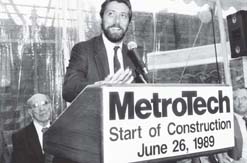
Jim Stuckey in 1989 at the start of construction of the Metrotech Center. Courtesy of Jim Stuckey
JIM STUCKEY “During the years when I was growing up there were all sorts of fights between the Puerto Rican gangs and the white gangs. It was very much a West Side Story kind of situation. Unfortunately, I was not always a spectator, but I don’t want to glorify it. You would find yourself where a gang of kids would be roaming the neighborhood. There were the Savages, a Puerto Rican gang, another gang called the Young Savages, kids who were younger, and I remember the Flying Dutchmen, a white gang from Bensonhurst. There was a lot of real serious fighting, knives, ripping antennas off cars, throwing bottles, tough stuff.
“I went to grammar school at PS 94 on Sixth Avenue and 51st Street, and I rarely saw African-Americans, but when I got to junior high school—I went to Pershing Junior High, JHS 220, on 49th Street and Ninth Avenue—there was a lot of busing, and interestingly enough, I made a lot of friends from neighborhoods like Fort Greene and other downtown Brooklyn neighborhoods, and the same was true when I began Fort Hamilton High School in 1970. In part to escape being around the gangs in my neighborhood, I began hanging out with a couple friends from the black neighborhood down near Fort Greene, areas close to the Atlantic Yards, which we are now developing. You’re talking about how the world positions you.
“It’s interesting, because these are the things that shape your life. I had a great friend, Maurice Skipper. We went to Pershing and then Fort Hamilton High. Maurice had an older brother, Ben, who was a fabulous basketball player. He preceded Bernard King at Fort Hamilton. I don’t know why he never went further. I heard later on he died. I don’t know if that’s true or not. Maurice and I were super, super friends. That whole friendship came about as a result of busing and the integration efforts of the time. He and I always would hang out. It caused me to come down to some of the downtown neighborhoods and explore the city. He would come into my neighborhood, and we had a great friendship. We lost touch when I went to college at St. John’s. It was unfortunate, because he was almost a soulmate.
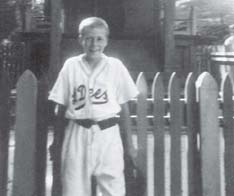
At age nine on the L Dees baseball team.
Courtesy of Jim Stuckey
“But busing further added to the tensions existing between certain communities. You were adding another party to the mix, the African-Americans.
“In retrospect I think about how close-knit the city is today and how many friends I have of all nationalities and ethnicities, and to think in the ’60s and ’70s you had in many ways a more insidious and deeper type of discrimination than you did in the South, where people openly practiced it. Here you had cities like New York and Boston where people acted as if it was okay to live alongside minorities, but really didn’t. I think how insane those times were.
“I took the lead on negotiating for our office, community benefits agreement for the Atlantic Yards project. I think deep down inside, how my empathy for the less well-off led me to make sure some of the local groups—predominantly African-American and Caribbean-American groups, will be involved in the job growth and the development of the Atlantic Yards project. Minority-and women-owned contractors will get health care in communities that unfortunately don’t get appropriate health care, educational initiatives. I look back and wonder how maybe those years were very formative in my understanding how important it is today to do a community benefit. It’s not because you read about it being socially correct but because you lived through the eyes of other people.
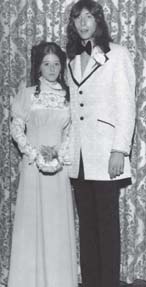
At age eighteen at his prom with his future wife, Debbie. Courtesy of Jim Stuckey
“When I was in high school, my family worried I would never go to college because I almost always failed my first and last class, because I always cut them. It wasn’t because I couldn’t do chemistry or trigonometry, but in the morning my friends and I would go have breakfast. In the afternoon we’d go hang out someplace. Sometimes it was because I had a job. When I was a kid, I loved sports, and I made the varsity baseball team, but I decided there was no way in the world I was going to play, because it was much more important to go work at a delicatessen stacking boxes so I could make some money. That was indeed what was important at the time.
“My dad was an accountant. Ultimately he worked his way up to having a very good comptroller’s job, but when we were young, honestly, we lived in a very small, three-room apartment. We didn’t have much. My brother and I, going to bed, would roll out the Castro Convertible. It was a very modest, humble setting, but I had a wonderful family.
“I went to St. John’s, and I managed to get through it in three years. I graduated college magna cum laude, and I went to graduate school at St. John’s. They offered me an assistantship, and I did a master’s in experimental and physiological psychology. Twenty-five years later, in 2002, I got a second graduate degree, in sacred scripture and theology from St. Joseph’s seminary.
“My first job, which is kind of perverse, was as a social worker at the Mount Loretta Home on Staten Island. The job was an intake worker, and what was perverse about it, I would have to go to people’s homes and make recommendations to the family court in Brooklyn about whether or not kids should be permitted to stay in their homes, either because of abuse or drug situations. It was a terrible job. Twenty-five years later, working for Forest City Ratner, I had the good experience of being able to rebuild that court. When I went there, I would walk in, and because it was so antiquated, you’d have families fighting in hallways, find guns hidden in the hedges, and lawyers had to interview their clients in bathrooms. It was really bad. As I said, you never know how those experiences shape something you can touch later.
“That job lasted about six months, and in October 1977, I was offered an opportunity to work in the city, doing personnel work in something called the Office of Economic Development. Doing personnel work seemed obvious for someone with degrees in psychology and a bachelor in business, and right at that time Ed Koch became mayor and a new team of people came in, and to my benefit they saw I was capable of doing more than personnel work, and as time went on with the Office of Economic Development, they began to expose me to other opportunities, one of which was getting involved in real estate development for the city.
“The first project I got exposed to was the South Street Seaport. I worked really hard on that, and within a short period of time, around 1980, we got the project approved and began moving into construction. It was clear I had discovered a job that was both fun and that I was good at and enjoyed, and ultimately something I could make a career of, because at that time I also had my first child and also was working on getting my doctorate in psychology.
“As I continued working for the city in development, I got more and more exposure and particularly began to get more exposure to the mayor, who I didn’t know. I was not political in any way.
“I thought Ed Koch was absolutely terrific. He was an incredibly talented and smart man. I’m impressed with the current mayor [Mike Bloomberg], and I think Ed Koch was a great mayor, and fortunately he got to see what I was able to do—I worked for some really good people who were not shy about letting me shine a little bit—and by 1986 I was asked by the mayor to become president of what is now called the Economic Development Corporation, what was then called the Public Development Corporation. In that capacity I stayed president for three and a half years, until 1990, and during that time I oversaw $15 billion in projects for the city.
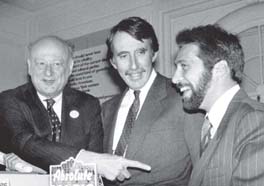
A press conference in 1987 with Mayor Koch, left, and UDC President Vince Tese, right. Courtesy of Jim Stuckey
“Among those projects were MetroTech; Times Square redevelopment; 42nd Street redevelopment; the Brooklyn Army Terminal, a major industrial facility; the retention of what was then called Shearson-Lehman-Hutton; the Citicorp Center in Long Island City, which you see when you drive down the BQE; a number of the city’s industrial parks; the heliport—projects that helped to create or retain about a hundred thousand jobs in New York City. Most of these projects were brought by developers, and it was primarily the Public Development Corporation’s responsibility to oversee and negotiate on behalf of the city.
“I would negotiate the business deal whether it was negotiating a lease, bringing it to a public approval process, or handling the environmental side.
“When I began working for the city, Bruce Ratner was working at Consumer Affairs. He was its commissioner in the early ’80s. I didn’t know him well, but I knew who he was. When the MetroTech project began, I was not dealing with Bruce. I was predominantly dealing with Bruce’s cousins from Cleveland—Albert Ratner, our current chairman, and Jimmy Ratner, the head of the commercial arm of the company out of Cleveland. Forest City had not yet opened an office in New York City.
“It was mainly the people from Cleveland I was working with in the early stages of MetroTech. A year or two later, Bruce joined the company when he merged his company with Forest City, and then I indeed began meeting more with Bruce.”
When Ed Koch lost the Democratic nomination for mayor to David Dinkins in 1990, Jim Stuckey, knowing that Dinkins would want his own man to head the Office of Economic Development, resigned. He had worked with a lot of different developers, so he knew he wouldn’t have much trouble finding a job in the private sector, but he had spent the last thirteen years working in government, and he didn’t want to rush into a decision.
He became a consultant, and the first job he accepted was with Forest City Developers to build a project in the South Loop area of Chicago, near Soldier Field, called Central Station. For six months he commuted to the Windy City to help the Ratners get through the approval process. He also helped them put together tax increment financing with the city and the state of Illinois. They had other plans: an office building and an international trade center, and he worked with Forest City on those projects as well.
When he finished in Chicago, he returned to New York.
JIM STUCKEY “I joined Forest City Ratner in 1994. The first buildings we did were the 330 Jay Street courthouse, the headquarters for the fire department, the Times Square/Madame Tussaud AMC project, the Hilton Hotel, the Mercantile Exchange in Battery Park City, the Embassy Suites Hotel.
“Then Bruce got a call from Marty Markowitz. If you go back to when Marty became borough president in 2002, one of his platforms was to bring a professional sports team to Brooklyn. When he first called, he wasn’t partial to whether it was baseball, basketball, hockey, or soccer. He was just pushing for a professional sports team. Some sports were more logical than others; basketball always being the most logical. Marty believed there should be a professional team, and along with it was the question: Where should it be located? Should it be in Coney Island? The Brooklyn Navy Yard? The idea of doing it at the Atlantic Yards was not necessarily a front-burner idea on anyone’s plate. And then, as much as Marty pushed, Bruce agreed that we would look into this.
“We had redeveloped Times Square, so the idea of doing an entertainment facility was not a crazy idea for us. So we began to look, and before we knew it, we learned that the New Jersey Devils hockey team was for sale. We looked at it seriously and put in a bid, but our goal, quite honestly, wasn’t to buy the Devils for the sake of buying the Devils, but to buy the Devils so we could also buy the Nets, because we realized that basketball was much more important, was a much better economic gamble, a better fit for Brooklyn than hockey.
“The owners of the Devils, a company called the YankeeNets, was made up of Ray Chambers of the Nets and George Steinbrenner of the Yankees. They had formed a company because they felt there was going to be real synergy in having a basketball team, a hockey team, and the Yankees, as well as the YES network. Put it all together, and you’d be able to get something greater than the sum of its parts. But it didn’t work out. The partnership didn’t work, despite the fact that they tried, and it became clear they had to break this whole thing up.
“They began by trying to sell the Devils, but ultimately Ray Chambers decided to keep it. He really wanted the hockey team for an arena he wanted to build in Newark, so he kept the Devils, and to our surprise he then put the Nets up for sale. Which was what we wanted in the first place.
“There was competition to buy the Nets. We were competing against one group, which included now-Governor Corzine, that wanted to keep the team in New Jersey. We were also competing against a team out in Long Island that owned the Islanders [Charles Wang and Sanjay Kumar, who sold his shares to Wang in 2006 after pleading guilty to securities fraud]. So we did have real competition.
“The winner would have to satisfy the NBA, but the problem for the New Jersey group was that the past ownership had teams going to the finals but they could not get the arena filled. We had to show we could get the project built. We were able to show we had a business plan that went beyond a simple arena, because sports economics are not always the best in the world, and this would be a larger development that made the economics work better.
“As we began pursuing the team, part of the process was picking a site, and when we looked at it closely, it became clear that the only place in Brooklyn a real good sports facility worked would be at the Atlantic Yards, predominantly because of the public transportation—the ability to move people using public transportation is huge.
“When it came time to put in a bid, there was a lot of drama and a lot of hard work. You’re bidding and putting together your economics, figuring out the right purchase price and how you’re going to put together your equity and financing.
“We won the bidding by a fair margin. Our bid was $300 million. It wasn’t leaps and bounds above the other competitors. The bid was better, but the other factor was that the team would come to Brooklyn. That played a big role in the old ownership selling the team, because the deal had to be approved by the NBA, and I think the NBA was excited we were bringing the team to Brooklyn. I think all of this contributed to that success.
“And once we bought the team, our next steps were very, very complicated.”
Ratner, Stuckey, and company would have an endless row of hoops they would have to jump through—approval from the state and the governor, approval from the mayor, from councils, boards, environmental tests, and on and on. I asked Stuckey whether there was a possibility that after they bought the team, the NBA wouldn’t allow them to move it to Brooklyn, whether there was a possibility the government would halt the project.
JIM STUCKEY “That was always a risk, because one can never assume that just because we thought it was a good idea that the government would. Some people like to think we have that kind of magic wand we can wave, but the truth of the matter is that government acts very independently, and there were multiple levels of government that had to be involved. Ultimately we had to be approved in the state process, but we had to have the city planning people help us with design. We had to negotiate a business deal with both the state and the city. We had to get approved by the Public Authorities Control Board, the governor, the legislature—assembly and senate.
“And in the course of the last two or three years I have gone to over two hundred community meetings and had to go before the city council twice. We’ve had to complete full environmental impact statements on this project. We have three or four lawsuits still hanging around, concerning eminent domain. We made a calculated decision to try to limit the issues of eminent domain by going out and assembling 85 percent of the site, particularly focusing on assembling people’s homes and businesses first, because we realized that they were going to be most sensitive, and we didn’t want to have to worry about where they were going to live. We worked diligently to make fair deals, buy people’s homes and businesses so what’s left, predominantly, that has to be condemned are vacant lots and abandoned buildings, chop shops, places like that.
“All this had to be coordinated. While Bruce and other people were spending their time on the acquisition of the team, I was working with the real estate team trying to figure out if we were to win it, how we were going to get this through the approvals, through the litigation, and ultimately to build. I’ve been at this around three and a half years now, and it has been a long, Herculean effort.
“We have been approved. We have begun to do some of the infrastructure work on the Long Island Rail Road. We have begun some of the demolition work, and we are now fighting the litigation, but the fact is in the fall of this year [2007] we could very well be in a position where we could start to see the arena coming out of the ground, or at least the excavation for it. In the meantime there’s a bunch of infrastructure work that needs to be done, and this would have to be done with or without lawsuits, and we’re doing that so we can try to keep this thing on schedule.”
In addition to the basketball arena, the plan calls for sixteen high-rise buildings. As with the MetroTech Center, the Atlantic Yards will be built in phases.
JIM STUCKEY “First we are going to build what we call the ‘arena block,’ which is the arena and four buildings around it, as well as one other building, which we refer to as Site Five, a building across the street, technically outside of the Atlantic Yards but part of the approval. That phase of the development is scheduled to be completed by 2010, and that will include rental units and office development, some retail space, and possibly a hotel. Then the second phase, all the buildings east of Sixth Avenue and Vanderbilt Avenue, will all be residential buildings. When it’s all done, there will be a total of 4,500 rental units, half of which will be affordable. There will be about 1,930 condo units. There will be a half a million feet of office space. Plus the arena itself, and up to 180 hotel rooms.”
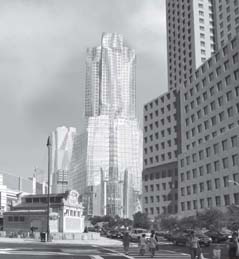
An artist’s rendering of part of the Atlantic Yards—the Frank Gehry–designed arena and “Miss Brooklyn” tower at the intersection of 4th, Flatbush, and Atlantic avenues. Forest City Ratner
While researching Jim Stuckey’s interview, I saw that the opposition to the Atlantic Yards project was fierce and constant. I read Stuckey a laundry list of the major complaints: the project is too big; it will bring too many people to the area; there isn’t enough low-income housing in the project; the character of downtown Brooklyn will change too dramatically; the area will become too much like Manhattan; Bruce Ratner will make too much profit; the project tears down too many landmarks; the public schools will become too crowded; Ratner has tricked everyone using sleight of hand; the tax giveaways are too great; the centerpiece of the project, Frank Gehry’s sixty-five-story building, is ugly; the residents were never consulted; blacks will be driven out of central Brooklyn; who wants a basketball team anyway?; and finally, the only reason Ratner is doing this is for the money. I could hear Stuckey let out a long sigh when my recitation was completed.
JIM STUCKEY “I’ve heard all of those too. And we obviously have responded. Let’s step back from the specifics of all those criticisms for a second, and let’s look at what we’re doing and why we’re doing it. In my mind, the beauty of working here at Forest City, and I think it’s also true of Bruce and many others, is that we can involve ourselves in a great business where we can also make a difference for other people from a social, moral, and economic point of view. All the goals and good things Bruce and I have felt when we were in government, all the things that motivated me at one point in my life to go to school for psychology and to get a second degree in theology, all those things we can live for and do in the job, we do here. We don’t build monuments. People will live in, shop in, recreate in, and work in the buildings we are building. You have to start from the basic premise that we wouldn’t go bankrupt building it, that people are going to use and occupy these buildings. That takes you to your next step, which is that we are building in a city that needs to grow. Like any other organism, if a city doesn’t grow, it dies. Your cells constantly need replenishing and need to grow, and that’s true with a city as well. And if it grows too quickly, you have cancer and you die.
“You’re looking at a situation where this city has an incredible housing crisis, where the vacancy rate stands at almost 1 percent. At the same time if you look at the next ten to fifteen years, we’re going to have a million more people living in New York. Of those, 300,000 to 400,000 are expected to settle in Brooklyn.
“It’s already not affordable. You have less middle class in New York City than you have in any other major city in the country. And so how do you reconcile the fact that you don’t have growth in this city? You can’t. You can’t possibly reconcile it.
“And then you have to also look at the fact that the ones who get hurt traditionally are the poorer people, the minority populations. In fact, if you were to look at the demographics in Brooklyn, and if you were looking at the people lobbing the criticism, largely they are the wealthier people who have lived in the neighborhood less than ten years—most less than five years. Most of them have advanced degrees, and if you look at what’s happening over time in these neighborhoods, the poorer, predominantly African-and Caribbean-American population is being forced out. So now you say, where do you build? Well, in Brooklyn, less than 4 percent of the land is vacant. The question then is, if you recognize you must build, where do you build, especially when less than 4 percent of the land is vacant? Doesn’t it make implicit sense to build densely where you have mass transportation?
“I will answer my own question. Every major planning agency in the world, and more specifically the regional planning agencies, will tell you that the perfect planning scenario is to put density where there is mass transportation. Which is exactly what we are doing. Now layer on top of that the fact that in order to build this, we’ve had to spend a tremendous amount of money to acquire properties, to acquire condemnation, and on top of that we have had to spend about $600 million on infrastructure, building platforms, relocating rail yards, doing subway connections, doing new sewer and water mains, rebuilding bridges over Sixth Avenue and Carlton Avenue—it’s going to cost $50 million alone just to clean up the dirty soil there. So before you put a shovel in the ground, you have close to a billion dollars in cost between the infrastructure and the land. So the basic economics demands you do a certain density if you’re going to build there at all.
“So I will submit to you that while it’s very easy to be critical and to stick one’s head in the sand and just make believe these problems are going to go away—don’t put it in my backyard—there is an absolute responsibility, not just the government, but every one of us who lives in New York City, to make sure we do things to solve these problems.
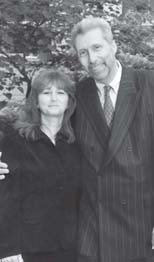
Jim Stuckey and wife Debbie celebrate their thirty-third wedding anniversary.
Courtesy of Jim Stuckey
“Now for better or worse, our job is to be a developer. For better or worse. And I come full circle and say if it weren’t going to be occupied by somebody, we wouldn’t build it. So while it’s easy to make the developer the target—it’s a TV storyline: corrupt officials, big developer, overdevelopment—we can all write that script. We’ve seen it on TV a million times. But when you peel back the onion, there’s not a shred of truth to it. Everyone knows the hundreds of meetings I’ve been to. They can’t dispute that I’ve gone out into the community more than two hundred times. They can’t dispute the fact I’ve made two city council presentations, the first one in 2004 and the second in 2005. The project only got approved at the end of 2006. Those are matters of record. I’ve gone to community board meetings where we had support from more than nine hundred people from three community boards. But the opposition to this project hopes if they say something enough times, people will believe it.
“Well, the fact is, it’s not true. Unless the city steps up, unless the people step up and do this, then this city is a goner, it’s dead. It will become the next Detroit or Pittsburgh or Buffalo or other cities where people see there is no growth and decide to leave. If companies don’t have workers who can live in the city they are going to go to cities where they can get cheap labor. This is not rocket science. You can see how strongly I feel about this.
“These criticisms are not the community view. Polling shows that close to 70 percent of the people in both Brooklyn and New York City as a whole support this project.”
With the recent downturn in the real estate market and the economy, it seems as though the ambitious Atlantic Yards project has hit some roadblocks. Although construction may be delayed, Jim Stuckey is confident it will be built.